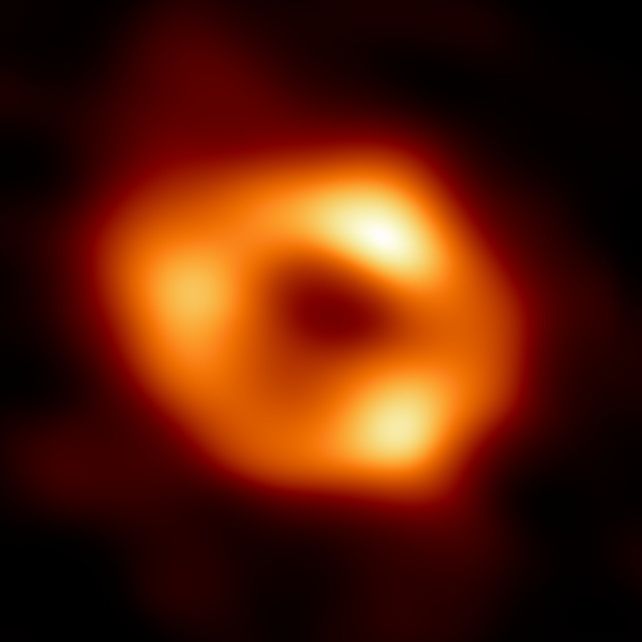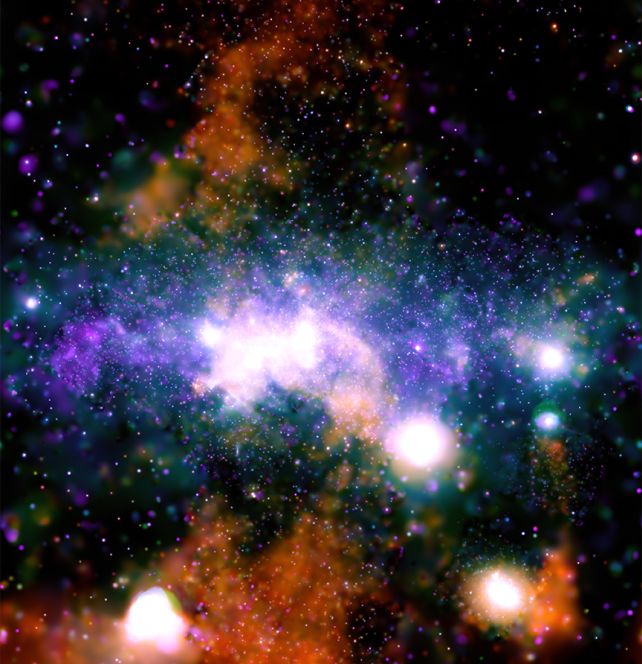Compared to some other galaxies out there, the supermassive black hole at the heart of the Milky Way isn't a particularly active one. It's not guzzling down scads of material, and it's not blasting giant jets of plasma into space.
Even a relatively peaceful supermassive black hole, however, is a wild, savage beast, and our own – named Sagittarius A* – has been recorded doing some pretty strange things. And now there's a new one: astrophysicists Gustavo Magallanes-Guijón and Sergio Mendoza of National Autonomous University of Mexico have recorded it sort of… pulsing.
Every 76 minutes, like clockwork, the gamma-ray flux of Sgr A* fluctuates. This, the researchers say, is similar in periodicity to changes in the black hole's radio and X-ray emission too, suggesting an orbital motion of something whirling madly around the black hole.
The results, awaiting peer review, can be found on preprint server arXiv.
Black holes themselves emit no radiation we can currently detect. They are darker-than-dark shadows, invisible to the telescopes with which we probe the light streaming through the Universe. But the space around them is a different matter. In the extreme gravitational regime outside the event horizon of a black hole, a lot can happen.

From the region of Sagittarius A*, light is emitted in a multitude of wavelengths, and the strength of that light varies significantly over time. And, in at least some of those wavelengths, astronomers have discerned a pattern.
Radio waves fluctuate on a timescale of around 70 minutes or so, according to a paper published in 2022. And a 2017 paper showed a periodicity of 149 minutes underpinning the black hole's X-ray flares. That's around twice the periodicity of the radio – and now the gamma-ray – fluctuations.
It's only recently, in 2021, that gamma radiation was linked to Sgr A* with any confidence. Magallanes-Guijón and Mendoza thought that there might be some secrets hiding in the gamma-ray data, so they set about analyzing it. They took publicly available data recorded by the Fermi Gamma-ray Space Telescope between June and December 2022, processed it, and conducted a search for periodic patterns.
They found one. Every 76.32 minutes, according to their results, Sgr A* lets out a flare of gamma radiation – the most energetic wavelength range of light in the Universe.
The similarity with the periodicity of the radio and X-ray flares suggests an underlying common cause. The radio flare, the researchers say, has more or less the same periodicity as the gamma-ray flare. The X-ray flare, at 149 minutes, has double the periodicity; this is unlikely to be a coincidence, suggesting that its periodicity is a harmonic of the gamma-ray and radio periodicity.

Since the black hole itself emits no radiation, and such regular, repeated periodicity is often a sign of orbital motion, the physical mechanism is likely something orbiting the black hole. The 2022 paper concluded that something is probably a blob of hot gas held together by a powerful magnetic field that subjects particles to synchrotron acceleration, emitting radiation in the process.
That blob has an orbital distance from Sgr A* that's similar to that of Mercury around the Sun. But, with an orbital period of 70 to 80 minutes, it's traveling at insanely high speeds, some 30 percent of the speed of light.
Magallanes-Guijón and Mendoza say their results are consistent with that interpretation of the radio data, suggesting that the blob of gas is emitting across multiple wavelengths. As it orbits, the theory suggests, the blob lets out energetic flares. As it cools, it glows more strongly in radio light. The discovery of gamma-ray flares supports this model.
There are still some details to be ironed out, though. Black holes are notoriously hard to study, and Sgr A* is no exception. Further observations, across multiple wavelengths, could help shed more light (har har) on the dark and mysterious heart of our Milky Way.
The research is available on arXiv.
